The leather for railway market is projected to reach US$ 2.30 billion by 2031 from US$ 1.68 billion in 2024. The market is expected to register a CAGR of 4.6% during 2025–2031. The shift toward bio-based leather is likely to bring new trends into the market during the forecast period.
Leather for Railway Market Analysis
Governments of different countries and private players are investing in rail modernization programs, including premium interior upgrades, creating long-term demand for leather. Leather is essential to make the interior of trains appealing and comfortable and to offer travelers a high level of convenience. Synthetic or artificial leather is composed of a fabric base, such as polyester, consisting of an intimate finish and texture of leather with dye, wax, polyurethane (PU), or polyvinyl chloride (PVC). Artificial leather possesses more advantageous properties than genuine leather. It can be coated with finishes and colors, allowing more design flexibility than genuine leather. These features make artificial leather ideal for railway applications, providing buyers with more efficient and sustainable solutions.
Leather for Railway Market Overview
The leather used in railway applications is made from either genuine or artificial leather. Genuine leather, also known as natural leather, is derived from the hides of cattle, goats, buffalo, or others, which is a by-product of the meat processing industry. Artificial leather, also known as synthetic leather, is made using polyvinyl chloride or polyurethane to mimic the properties and texture of natural leather. Genuine leather is breathable, allowing vapor and heat to dissipate, ensuring a comfortable seating experience for passengers during long journeys. This feature makes the material suitable for use in railway applications, such as train seats, traction bellows, handle and grip bars, cushions and pillows, and others. The surging veganism and rising concerns about animal cruelty are giving rise to an increased demand for artificial leather in railway applications, contributing to market growth.
Customize This Report To Suit Your Requirement
You will get customization on any report - free of charge - including parts of this report, or country-level analysis, Excel Data pack, as well as avail great offers and discounts for start-ups & universities
Leather for Railway Market: Strategic Insights

- Get Top Key Market Trends of this report.This FREE sample will include data analysis, ranging from market trends to estimates and forecasts.
You will get customization on any report - free of charge - including parts of this report, or country-level analysis, Excel Data pack, as well as avail great offers and discounts for start-ups & universities
Leather for Railway Market: Strategic Insights

- Get Top Key Market Trends of this report.This FREE sample will include data analysis, ranging from market trends to estimates and forecasts.
Leather for Railway Market Drivers and Opportunities
Expansion of Rail Infrastructure and Urban Transit
Governments of developed and developing regions are investing in metro systems and regional train services to meet the rising demand for efficient mass public transportation. This growth directly impacts the demand for high-performance interior materials such as leather. As new trains are commissioned and older fleets are refurbished, the need for durable, comfortable, and aesthetically appealing materials becomes paramount. Leather consisting of premium look, long lifecycle, and ease of maintenance is well-suited for seating, headrests, armrests, and wall coverings in luxury and commuter trains. It offers a superior passenger experience while meeting stringent safety, fire-retardant, and hygiene standards required in public transport systems. China, India, and countries in the Middle East are expanding their urban rail networks. To modernize public transportation, Saudi Arabia has developed the Middle East's largest US$ 22 billion metro rail network for the public. Similarly, Europe and North America are modernizing their railway facilities by incorporating premium interiors to enhance customer satisfaction and compete with other modes of transport. These initiatives create opportunities for leather manufacturers and suppliers to provide compliant, sustainable, and customized leather solutions for railway interiors. The rising urbanization encourages a modal shift from road to rail, driving growth in metro and light rail transit projects. Thus, expanding rail infrastructure and urban transit propels the demand for leather in railway applications.
Rising Adoption of Artificial Leather
Synthetic or artificial leather is composed of a fabric base, such as polyester, consisting of an intimate finish and texture of leather with dye, wax, polyurethane (PU), or polyvinyl chloride (PVC). Artificial leather possesses more advantageous properties than genuine leather. While genuine leather is known for its durability, artificial leather has been proven to be equally or even more resistant to wear, water, and sunlight. It is easy to maintain and does not fade or crack as quickly as genuine leather when exposed to sunlight. Artificial leather can be coated with finishes and colors, allowing more design flexibility than genuine leather. These features make artificial leather ideal for railway applications, providing buyers with more efficient and sustainable solutions. It is cost-effective with efficient manufacturing processes, allowing railway operators to provide high-quality materials at more affordable prices for consumers and greater versatility. Genuine leather production involves high water usage and chemical tanning. Consumers increasingly favor synthetic leather variants as more eco-friendly options that reduce the carbon footprint.
Railway operators are shifting toward synthetic leather for interior applications and to contribute to a circular economy. In October 2024, Oriental Rail Infrastructure bagged a US$ 0.19 million order for Northeastern Railways (NER) in India. The project entails the manufacturing and supply of vinyl-coated upholstery fabric (artificial leather) for AC coaches (13,653 meters) and non-AC coaches (90,316 meters). The surging awareness, affordability of artificial leather, and sustainable production practices are expected to create future growth opportunities for the market.
Leather for Railway Market Report Segmentation Analysis
Key segments that contributed to the derivation of leather for railway market analysis are type, application, and train type.
- Based on type, the market is bifurcated into genuine leather and artificial leather. The artificial leather segment is segmented into polyurethane, polyvinyl chloride, and others. The artificial leather segment held a larger share of the market in 2024.
- By application, the leather for railway market is divided into train seats, traction bellows, handle and grip bars, cushions and pillows, and others. The train seats segment held the largest share of the market in 2024.
- Per train type, the market is segmented into passenger trains, freight trains, mining trains, and others. The passenger trains segment dominated the market in 2024.
Leather for Railway Market Share Analysis by Geography
The geographical scope of the leather for railway market is mainly divided into five regions: North America, Asia Pacific, Europe, the Middle East & Africa, and South & Central America.
Europe held a significant market share in 2024. The Europe leather for railway market is expanding, driven by increasing passenger traffic and a sustained emphasis on sustainable transportation solutions. According to Eurostat, in 2023, Europe's rail passenger transport surged to a record 429 billion passenger kilometers, marking an 11.2% increase compared to 2022. This growth underscores the surging demand for enhanced railway infrastructure and services across the region, positioning rail transport as a cornerstone of Europe's commitment to reducing carbon emissions and promoting greener mobility. The leather for railway market is closely intertwined with these developments, as leather continues to be a preferred material for premium interior applications. In railway vehicles, leather is primarily used in seating parts, wall coverings, and partitions, where the material's durability, ease of maintenance, and aesthetic appeal are highly valued. Investments driven by the European Union's Green Deal and rail network modernization initiatives fuel the refurbishment and development of new rolling stock, amplifying the market for high-quality interior materials. The Leather Working Group (LWG) and other sector-specific organizations actively collaborate with railway manufacturers to promote sustainable leather production practices and lifecycle management, ensuring that leather varieties offered by vendors meet the functional demands of the railway sector and align with Europe's stringent environmental goals. As passenger expectations evolve toward comfort, safety, and style, the leather market in Europe's railway sector is poised for sustained growth, supported by regulatory frameworks and increasing passenger volumes.
Leather for Railway Market Regional Insights
The regional trends and factors influencing the Leather for Railway Market throughout the forecast period have been thoroughly explained by the analysts at Insight Partners. This section also discusses Leather for Railway Market segments and geography across North America, Europe, Asia Pacific, Middle East and Africa, and South and Central America.
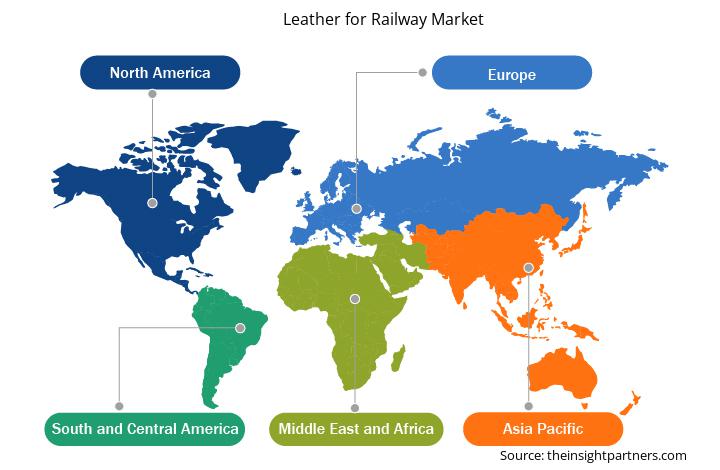
- Get the Regional Specific Data for Leather for Railway Market
Leather for Railway Market Report Scope
| Report Attribute | Details |
|---|---|
| Market size in 2024 | US$ 1.68 Billion |
| Market Size by 2031 | US$ 2.30 Billion |
| Global CAGR (2025 - 2031) | 4.6% |
| Historical Data | 2021-2023 |
| Forecast period | 2025-2031 |
| Segments Covered |
By Type
|
| Regions and Countries Covered | North America
|
| Market leaders and key company profiles |
Leather for Railway Market Players Density: Understanding Its Impact on Business Dynamics
The Leather for Railway Market is growing rapidly, driven by increasing end-user demand due to factors such as evolving consumer preferences, technological advancements, and greater awareness of the product's benefits. As demand rises, businesses are expanding their offerings, innovating to meet consumer needs, and capitalizing on emerging trends, which further fuels market growth.
Market players density refers to the distribution of firms or companies operating within a particular market or industry. It indicates how many competitors (market players) are present in a given market space relative to its size or total market value.
Major Companies operating in the Leather for Railway Market are:
- San Fang Chemical Industrial Co Ltd
- FILWEL Co Ltd
- BASF SE
- Kuraray Co Ltd
- Teijin Ltd
- Toray Industries Inc
Disclaimer: The companies listed above are not ranked in any particular order.
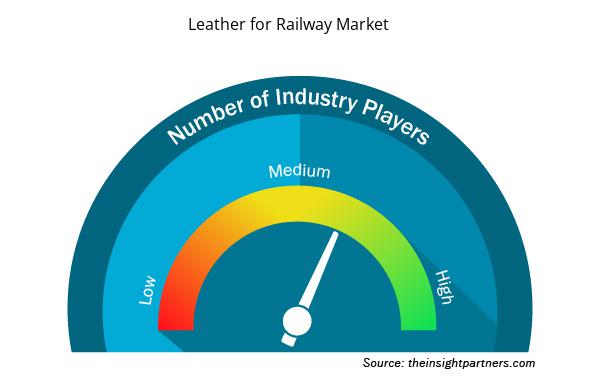
- Get the Leather for Railway Market top key players overview
Leather for Railway Market News and Recent Developments
The leather for railway market is evaluated by gathering qualitative and quantitative data post primary and secondary research, which includes important corporate publications, association data, and databases. Key development in the leather for railway market is mentioned below:
- Covestro and Huafon Group reinforced their commitment to sustainability by signing a Letter of Intent (LoI) at the China International Import Expo (CIIE). This partnership aims to expand the use of low-carbon materials from the German materials manufacturer within Huafon's product portfolio, thereby advancing the circular economy. (Source: Covestro, News Letter, November 2024)
Leather for Railway Market Report Coverage and Deliverables
The " Leather for Railway Market Size and Forecast (2021–2031)" report provides a detailed analysis of the market covering below areas:
- Leather for railway market share and forecast at global, regional, and country levels for all the key market segments covered under the scope
- Leather for railway market trends, as well as market dynamics such as drivers, restraints, and key opportunities
- Detailed Porter's Five Forces and SWOT analysis
- Leather for railway market covering key market trends, global and regional framework, major players, regulations, and recent market developments
- Industry landscape and competition analysis covering market concentration, heat map analysis, prominent players, and recent developments for the leather for railway market
- Detailed company profiles
- Historical Analysis (2 Years), Base Year, Forecast (7 Years) with CAGR
- PEST and SWOT Analysis
- Market Size Value / Volume - Global, Regional, Country
- Industry and Competitive Landscape
- Excel Dataset
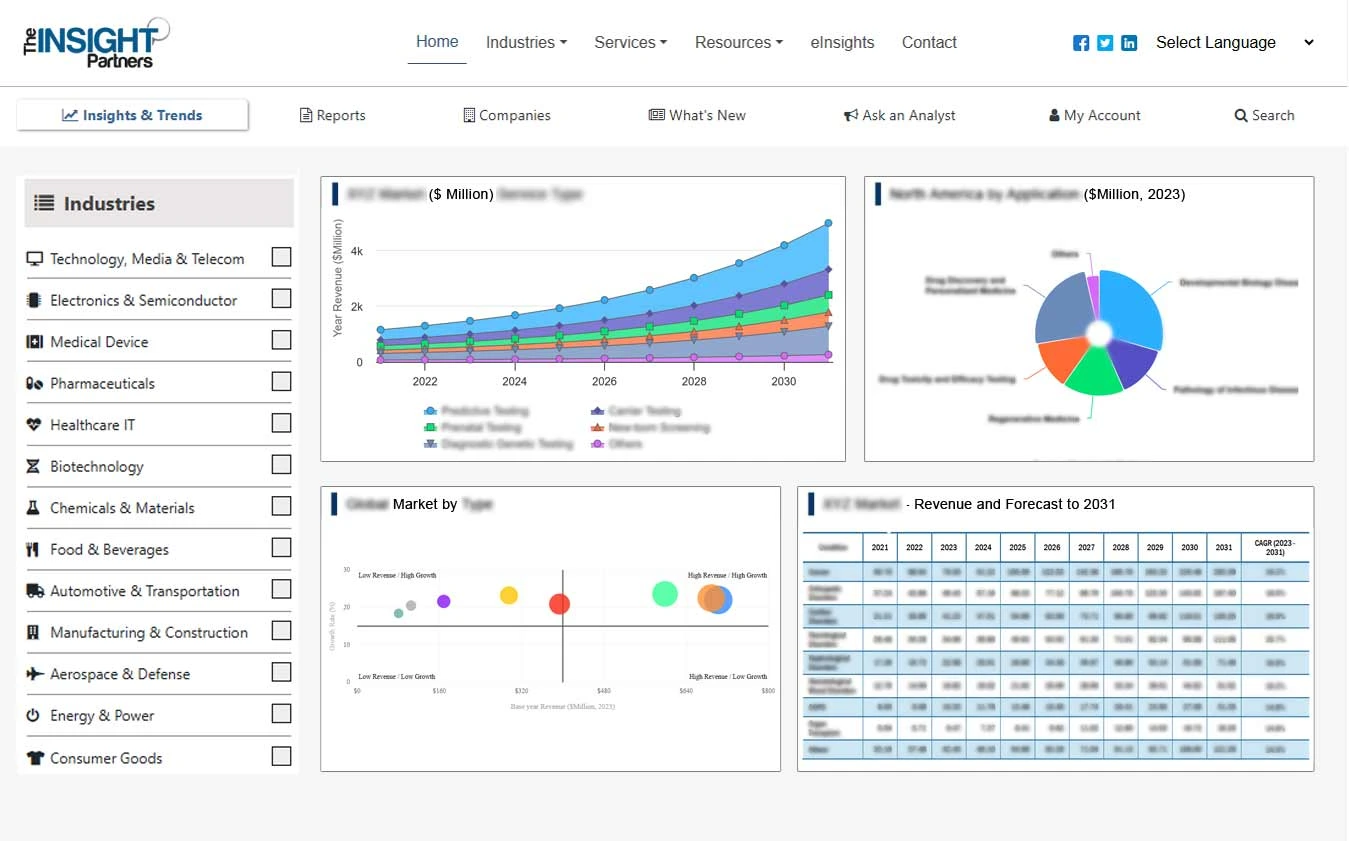
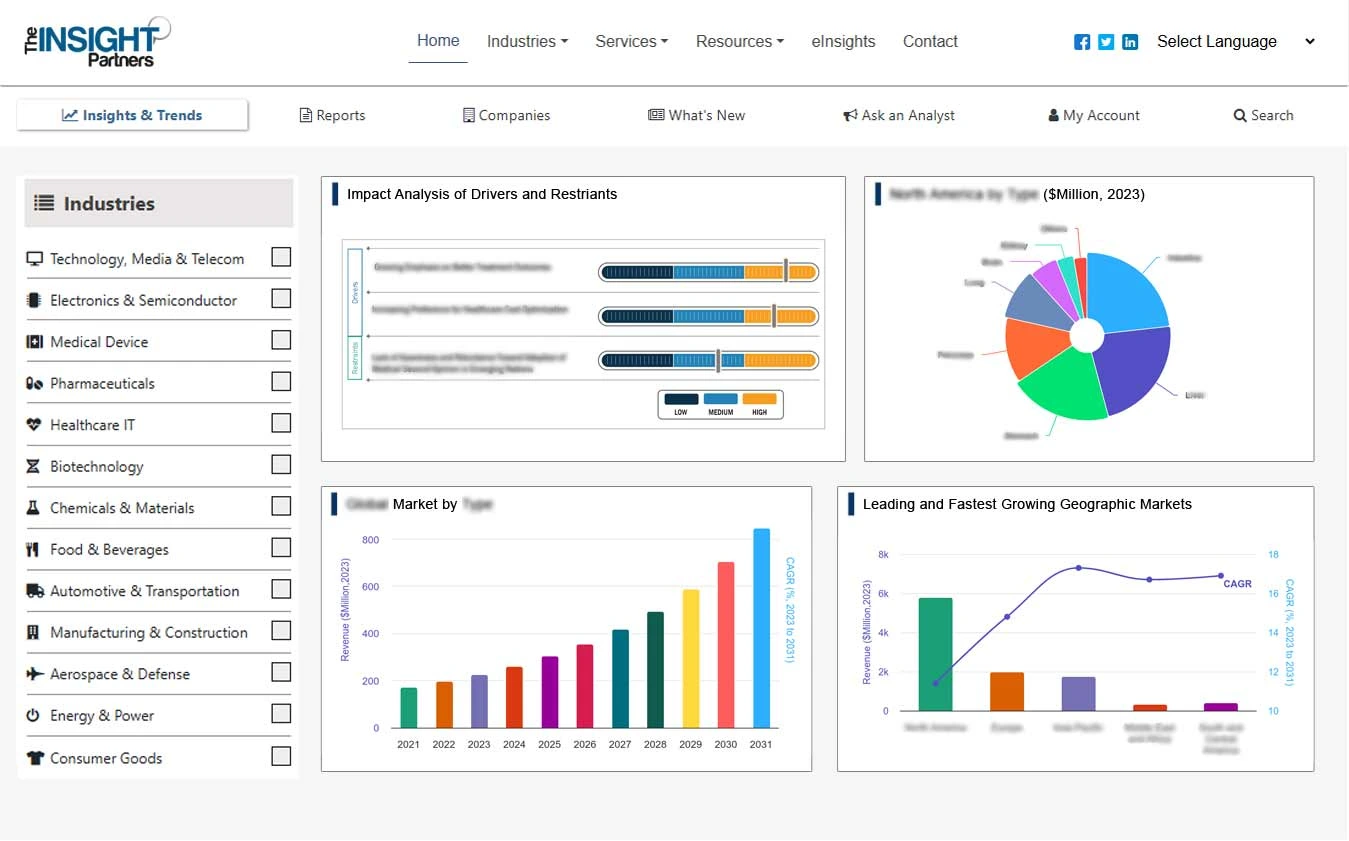

Report Coverage
Revenue forecast, Company Analysis, Industry landscape, Growth factors, and Trends

Segment Covered
This text is related
to segments covered.

Regional Scope
North America, Europe, Asia Pacific, Middle East & Africa, South & Central America

Country Scope
This text is related
to country scope.
Frequently Asked Questions
Which region dominated the leather for railway market in 2024?
Europe accounted for the largest share of the market in 2024.
What are the factors driving the leather for railway market growth?
The advancements in high-speed and premium rail services and the expansion of rail infrastructure and urban transit contribute to market growth.
What are the emerging trends in the leather for railway market?
The shift toward bio-based leather is likely to emerge as a key trend in the market in the future.
Which are the major players operating in the leather for railway market?
San Fang Chemical Industrial Co Ltd, FILWEL Co Ltd, BASF SE, Kuraray Co Ltd, Teijin Ltd, Toray Industries Inc, Covestro AG, Wollsdorf Leder Schmidt & Co GesmbH, Wickett-Craig, Super Tannery Ltd, Elmo Sweden AB, Giriraj Coated Fab PVT LTD, Conceria Leonica SpA, ICAIPLAST SpA, and BOXMARK Leather GmbH & Co KG are among the key players operating in the leather for railway market.
What would be the estimated value of the leather for railway market by 2031?
The market size is projected to reach US$ 2.30 billion by 2031.
Trends and growth analysis reports related to Chemicals and Materials : READ MORE..
The List of Companies - Leather for Railway Market
- San Fang Chemical Industrial Co Ltd
- FILWEL Co Ltd
- BASF SE
- Kuraray Co Ltd
- Teijin Ltd
- Toray Industries Inc
- Covestro AG
- Wollsdorf Leder Schmidt & Co GesmbH
- Wickett-Craig
- Super Tannery Ltd
- Elmo Sweden AB
- Giriraj Coated Fab PVT LTD
- Conceria Leonica SpA
- ICAIPLAST SpA
- BOXMARK Leather GmbH & Co KG
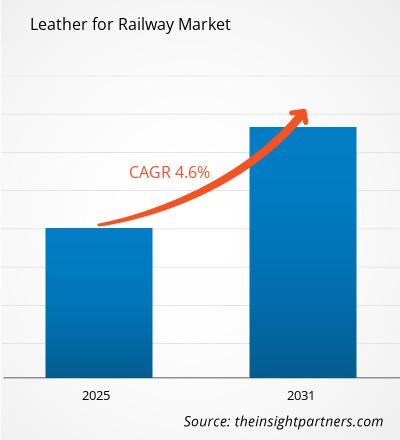
 Get Free Sample For
Get Free Sample For